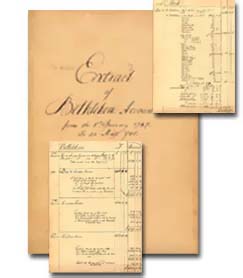 Business Activity
Business Activity
· 1758 Building & Land Specifications
· Ledgers/Extracts
· Inventories
· Distribution of Trades
· Papers

|
|
Bethlehem's Moravians were scrupulous record keepers, and this attention to detail extended to their financial affairs as well. Both for internal purposes and so that they could give accurate accountings of their financial status to church leaders in Germany, the Moravians kept daily records of cash and credit transactions, and summarized this information into running ledgers and annual "extracts." These extracts, generally based on a fiscal year that ran from June 1 to May 31, give a snap-shot of Bethlehem's finances from the perspective of the Diacony -- the community's financial arm -- and provide today's reader with a detailed picture of the economics of eighteenth-century Pennsylvania. Many of Bethlehem's financial records were kept in English, although the primary bookkeeper through the last half of the eighteenth century, Christian Frederick Oerter, was a native German. Furthermore, despite Bethlehem's strong ties to Continental Europe, the accounts use the local Pennsylvania Pound, rather than the British Pound Sterling or the German Reichsthaler. Like the British Pound of the eighteenth century, Pennsylvania Pounds (abbreviated L) were divided into shillings (abbreviated S) and pence (abbreviated d). There were 12 pence in a shilling, and 20 shillings in a pound. Katherine E. Carté |
Updated: 2 August 2005
